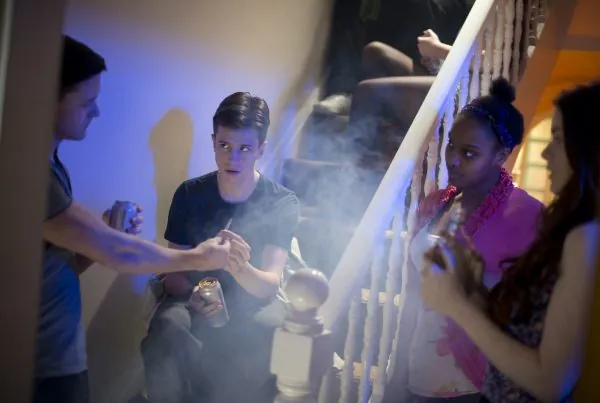We’ve all heard of CBD, which has grown quite popular amongst adults. But what is it? Is CBD for teens safe? And how is it different from marijuana substance use?
While only one CBD product is medically prescribed under very few circumstances – two rare forms of childhood epilepsy called Lennox-Gastaut syndrome and Dravet syndrome – they have seen a multitude of off-label uses over the last few years, and CBD products have hit the shelves advertising a vast number of potential benefits, from performance-enhancement to soothing anxiety, improving mood, and even managing symptoms of autism.
What is Cannabidiol (CBD)?
At its core, CBD (cannabidiol) is a hemp- or marijuana-derived cannabinoid. Cannabinoids are a class of substances that bind to cannabinoid receptors in the brain, sharing a similar chemical makeup to some of our own neurotransmitters. Cannabinoid receptors are a feature of the nervous system in most animals.
As a result, cannabinoids can affect the brain – and body – in different ways. Unlike other similar plant-derived compounds such as opium, cocaine, or even caffeine, CBD is not considered “psychoactive,” meaning it does not cause an altered state of mind or induce a sense of euphoria.
Tetrahydrocannabinol (THC)
THC, another cannabinoid, is responsible for the “high” that marijuana use induces. Some hemp plants are also primarily designed and genetically altered to reduce or eliminate the production of THC while retaining CBD. When CBD is extracted from a low-THC plant, it may still contain traces of THC. This is primarily the difference between isolate CBD (separated from other phytocannabinoids) and full-spectrum CBD (potential for low amounts of THC).
CBD in Foods and Supplements
Marketing CBD in a supplement or foodstuff is still illegal in the United States. Nevertheless, CBD products are becoming popular, especially online. Because the supplement market is not regulated as strictly as the pharmaceutical market, the only truly isolated CBD product is prescribed CBD or Epidiolex.
Other sources of CBD may be marketed as virtually THC-free on the Internet, but you would need to check with a lab to verify this.
Prescription CBD for Children
As a prescription drug, CBD’s current FDA-approved usage is primarily for children.
But that does not mean CBD for teens or adults is safe to use under most circumstances, especially because many CBD products retain the risk of containing low amounts of THC. But is that even a danger in and of itself? Here’s what we know.
How Does CBD Affect Teens?
In its purest form, CBD is a compound that interacts with similar receptors in the brain as THC, albeit very differently. While more research is being funded on the topic, the exact mechanism of action for CBD’s neurological effects is still unknown. Furthermore, the quality of the research behind CBD is often poor or leads to inconclusive results.
Some studies indicate that using CBD for teens with autism has a positive effect on reducing symptoms of anxiety, improving behavior and calmness, and dealing with symptoms of psychosis in individuals with schizophrenia.
FDA and Off-Label Use
But while FDA approval was reached for the use of CBD for rare forms of epilepsy, the FDA does not recommend any other off-label use for the drug, and there isn’t enough concrete evidence to support the idea that the use of CBD is beneficial in any significant way. Marketing hype, internet influencers, and online anecdotes remain the core of what drives CBD’s popularity.
Medical Supervision and CBD
That may not be enough to completely dismiss CBD’s usage for some. If you are interested in trying CBD yourself or as a potential anti-anxiety alternative for a loved one, it is important to try it under the supervision of a trusted physician.
In addition to helping you locate a higher-quality source of isolated CBD, a medical professional would also be able to guide you on dosage and advise against the use of CBD in conjunction with competing medication due to potential liver toxicity. Contraindicative medication aside, however, the side effects and short-term risks of CBD use are low.
On the other hand, the long-term risks of CBD for teens and adults remain unknown.
How is CBD Sold?
Outside of prescription medication, CBD is mostly sold in the form of an additive to baked goods and beverages or in the form of oil, candy, or transdermal patches.
CBD in foodstuff can be dangerous because it is virtually impossible to tell how much you are receiving in any given portion, and because CBD partially reconverts to THC under high heat.
Oil capsules, gummies, and transdermal patches provide a more accurate dosage, with patches providing the most consistent long-term delivery via the skin. However, the efficacy of any given CBD product lies entirely in how accurate the dosage is and the quality of the CBD, down to the level to which it is isolated from THC and other cannabinoids. Without proper regulation, you are left to make a choice on your own judgment.
Is CBD for Teens as Dangerous as Marijuana?
To use a different example – cocaine is a highly addictive, highly dangerous, and illegal drug. Most people know that cocaine is dangerous, and it has developed a deserved reputation as a party drug.
Did you also know that cocaine is primarily derived from a plant? And that millions of people consume part of this plant every day? To this day, decocainized coca plants continue to play an elemental role in the production of one of the world’s most popular products: Coca-Cola.
While Coca-Cola would famously contain a few grams of cocaine per bottle in years past, the modern-day incarnation of the drink still contains an extract from the same plant that cocaine is made from.
Without its addictive alkaline, the coca leaf is not dangerous. Nevertheless, decocainized coca leaf extract production is highly regulated, and only one company in the world supplies the multinational Coca-Cola company with the ingredient it uses in its soda. The other crucial ingredient is the kola nut, which provides the drink with its only psychoactive compound: caffeine.
Similarly, research shows that hemp has its benefits once you eliminate the psychoactive THC.
But is it also harmless? Truth be told, the jury is still out on that subject.
Marijuana is Still Illegal
Marijuana continues to be a federally scheduled drug, and it is still illegal in most parts of the United States and has been since 1970. This means that while much progress has been made in researching THC and CBD in recent years, it’s still difficult to secure funding for proper studies, which means there is a lot we don’t know about the long-term uses of marijuana-based products, especially cannabinoids like CBD.
While a decocainized coca leaf no longer carries any cocaine, cannabinoids like CBD do interact with the brain, mimicking some of our own neurotransmitters, which is why it sees potential as an anti-anxiety and anti-epileptic compound.
Do Your Research
At the end of the day, teens and parents alike should beware that CBD research is still relatively in its infancy, and off-label uses for CBD – whether to treat anxiety, autism, or acne – should be seen as early evidence at best rather than concrete proof. More time is needed to learn about CBD’s potential, its mechanism of action, as well as its side effects – especially in younger teens.
If you have questions about CBD for teens, always reach out to a trusted medical professional.
For more information about teen mental health disorders, visit Visions Treatment Centers.








